Rail Travel's Decline (USA): 1950s-1970s
Last revised: September 6, 2024
By: Adam Burns
The decline of trail travel began following World War II, as traffic dropped significantly, even while railroads began to update their passenger fleets with new equipment in the 1950s.
The idea behind this endeavor was to retain passengers and ward off ever increasing competition from the automobile and airplane (the development of jet propulsion only worsened the situation).
Technically, passenger rail travel peaked in this country during the first two decades of the 20th century and slowly declined thereafter, particularly with the onset of the Great Depression.
However, it also did not help that President Dwight Eisenhower enacted the Interstate Highway System in 1956 (also known as the National Interstate and Defense Highways Act).
By that time railroads were beginning to see the writing on the wall and cutback their services, with most giving it up altogether by the start of Amtrak in 1971.
Photos
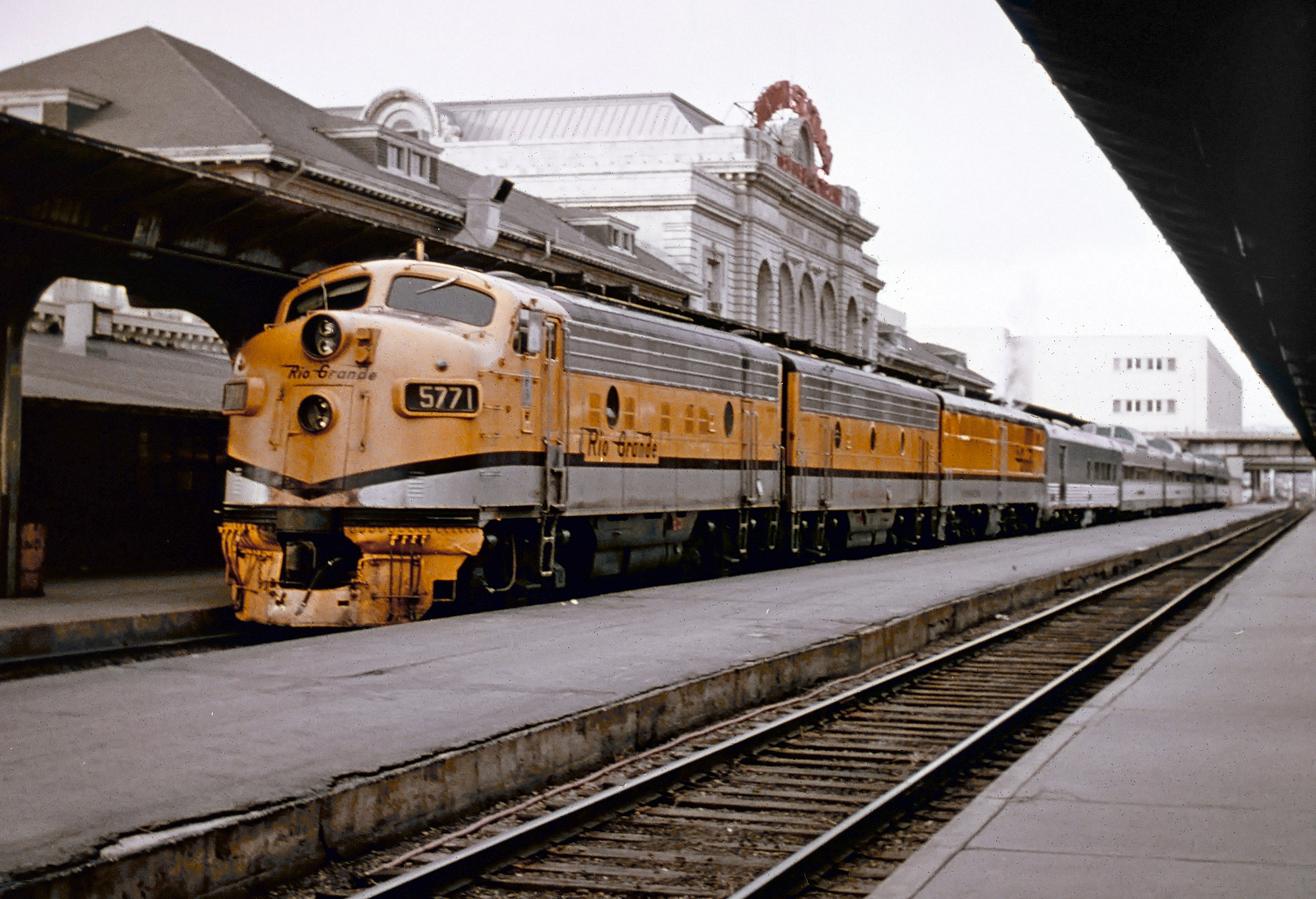 The Rio Grande continued to host a truncated version of the original "California Zephyr" until 1983, known as the "Rio Grande Zephyr." It operated only over D&RGW rails between Denver-Salt Lake City. Led by F9A #5771, the train is seen here at Denver Union Station on April 21, 1973. Joe Kmetz photo. American-Rails.com collection.
The Rio Grande continued to host a truncated version of the original "California Zephyr" until 1983, known as the "Rio Grande Zephyr." It operated only over D&RGW rails between Denver-Salt Lake City. Led by F9A #5771, the train is seen here at Denver Union Station on April 21, 1973. Joe Kmetz photo. American-Rails.com collection.History
Our high speed four lane corridors that we take for granted today did wonders in helping to improve travel but it was essentially the death blow for the “Golden Age” of passenger rail travel as people took to the highways in even greater numbers.
While new equipment in the 1950s helped bring back some passengers, overall the returns fell extremely short and in the end it only proved to be a costly waste of money as the decline only continued.
To make matters worse railroads were also losing a larger share of their bread and butter service, freight traffic to trucks that now had a high speed, free, and well maintained four-lane highway system to move goods.
While trucks are always more efficient at moving short-haul freight the new Interstate system was also taking away a larger share of the railroads’ long haul traffic.
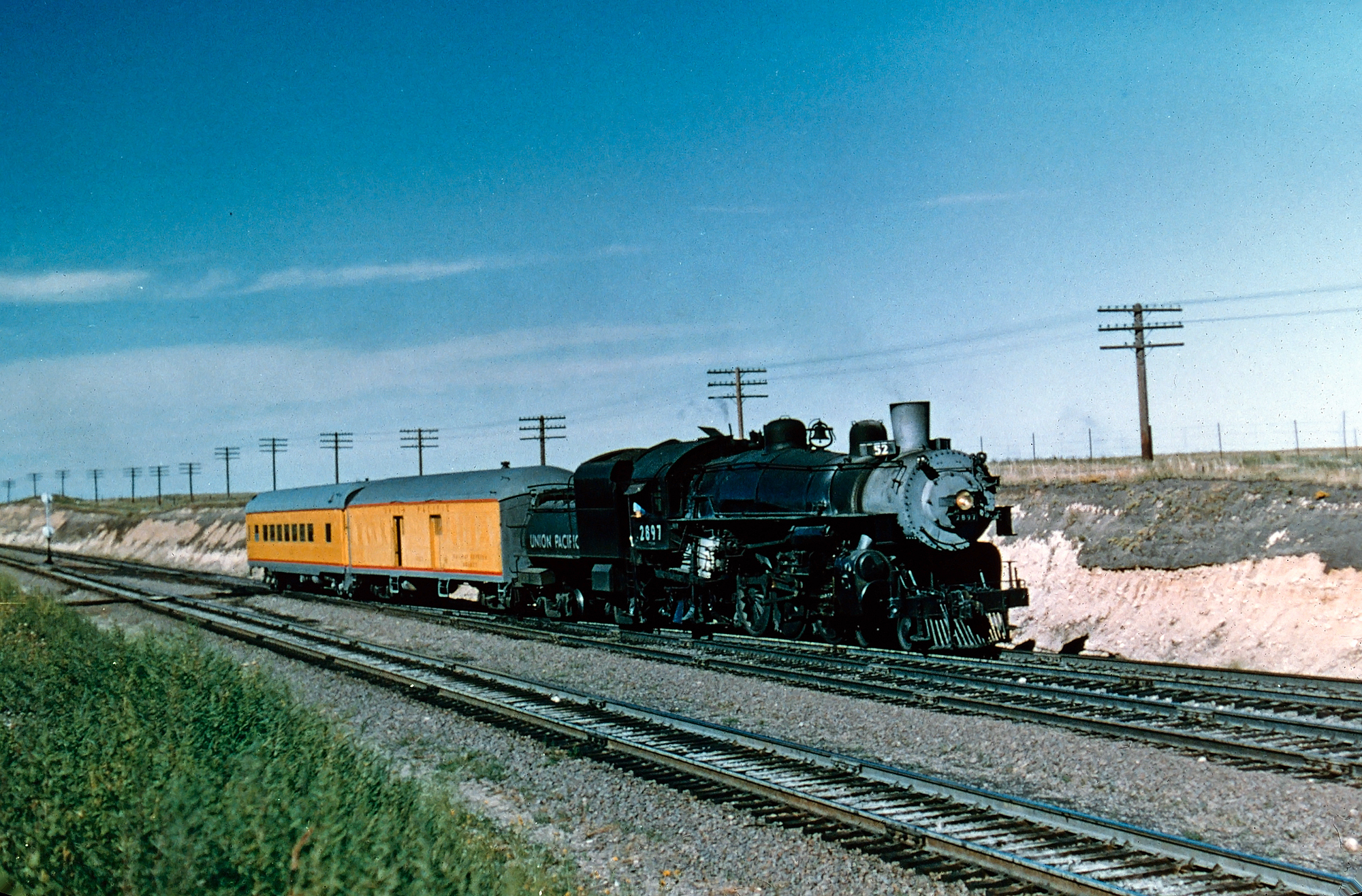 Union Pacific 4-6-2 #2897 has southbound train #52 (Cheyenne - Denver) working its way through Speer, Wyoming on August 31, 1955. John Shaw photo. American-Rails.com collection.
Union Pacific 4-6-2 #2897 has southbound train #52 (Cheyenne - Denver) working its way through Speer, Wyoming on August 31, 1955. John Shaw photo. American-Rails.com collection.Decline After World War II
For instance, by 1950 passenger revenue was 10 percent of freight revenue when in 1920 passenger revenue had been 20 percent of freight revenue.
While passenger trains are rarely profitable, before the 1950s railroads were earning enough that their freight revenues could easily offset the losses.
Also, in just a decades span between 1947 and 1957 operating mileage by passenger trains dropped from 160,000 (1947) to 112,000 (1957) and would continue into the following years.
It can be said (which is true) that one reason for the decline and the “depression” of the railroad industry as a whole, which occurred beginning in the 1950s until deregulation in 1980, is the result of severe sanctions and regulation by the Interstate Commerce Commission (ICC).
However, the railroads also, in a way, caused their own downfall by the shoddy and monopolistic practices they took part in during the 19th and early 20th centuries (which resulted in many of the regulations imposed on them). A few stats regarding the decline during these years:
- Between an 18-year span following the year after World War II, 1946, passenger traffic declined from 770 million to 298 million by 1964.
- By the 1950s total industry losses on passenger rail service was over $700 million.
- Commuter trains declined by 80% from over 2,500 in the mid-1950s to under 500 by the late 1960s.
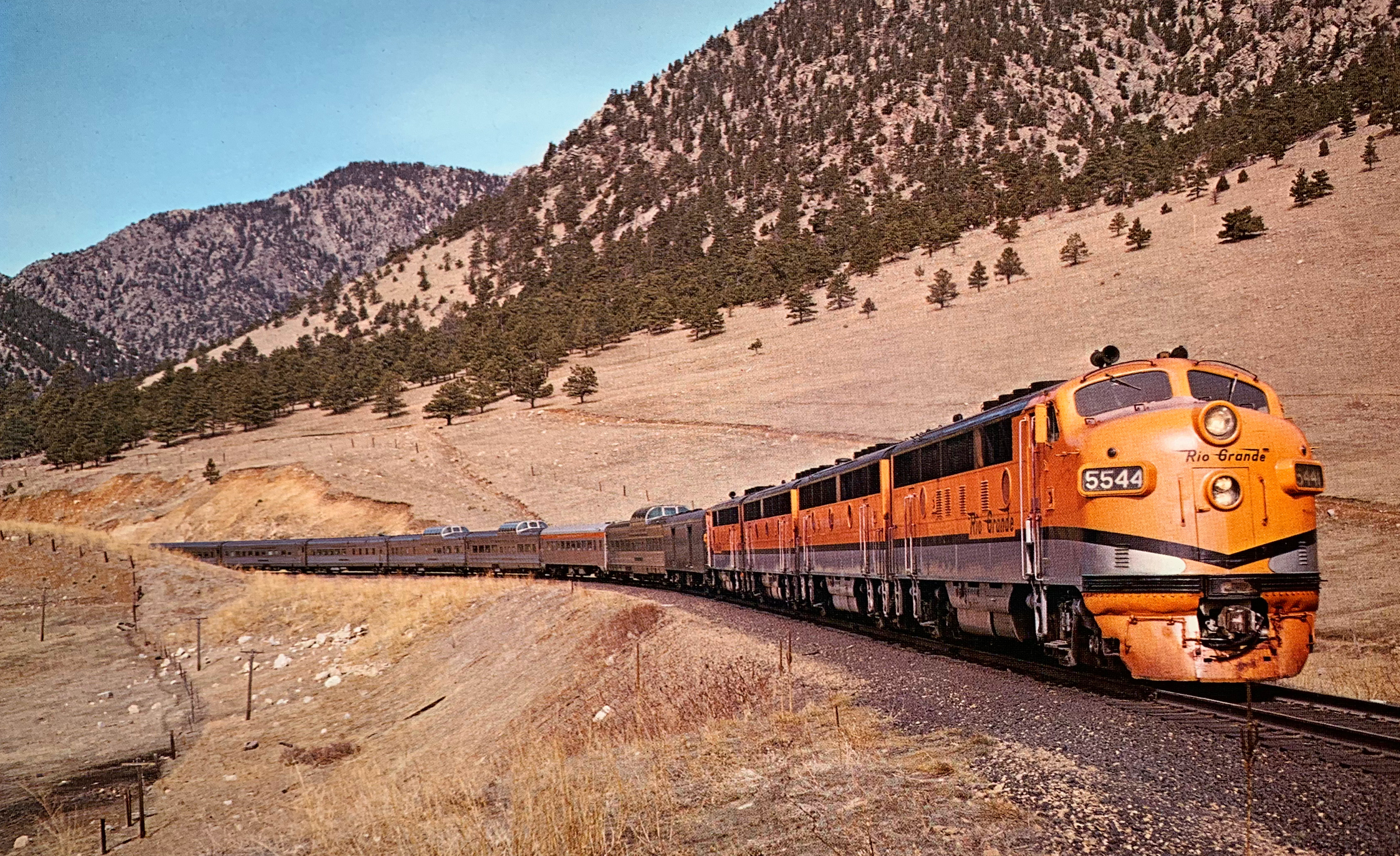 A Rio Grande publicity photo featuring the late-era "California Zephyr" headed west near Plainview, Colorado. Author's collection.
A Rio Grande publicity photo featuring the late-era "California Zephyr" headed west near Plainview, Colorado. Author's collection.In any event, by the 1960s three things were clear about the decline:
- One, because of the heavy regulation laid down on the industry it was no longer a threat to take part in such shoddy practices.
- Two, because railroads were forced to provide passenger service, which by now was only severely draining their profits if something was not done the industry would be near total collapse.
- Three, because of these heavy losses railroads desperately wanted to cut whatever they could to save money (which was tough considering heavy regulation forbid them from abandoning rail lines, canceling a passenger train[s], laying off workers, or raising/lowering freight charges all without ICC approval).
As a Boston & Maine official was once quoted as saying, "Every rate case has become a carnival of oratory." The 1960s also saw the end of the government’s lucrative mail contracts it held with the railroads and only furthered the decline as its loss was a severe blow to passenger traffic earnings.
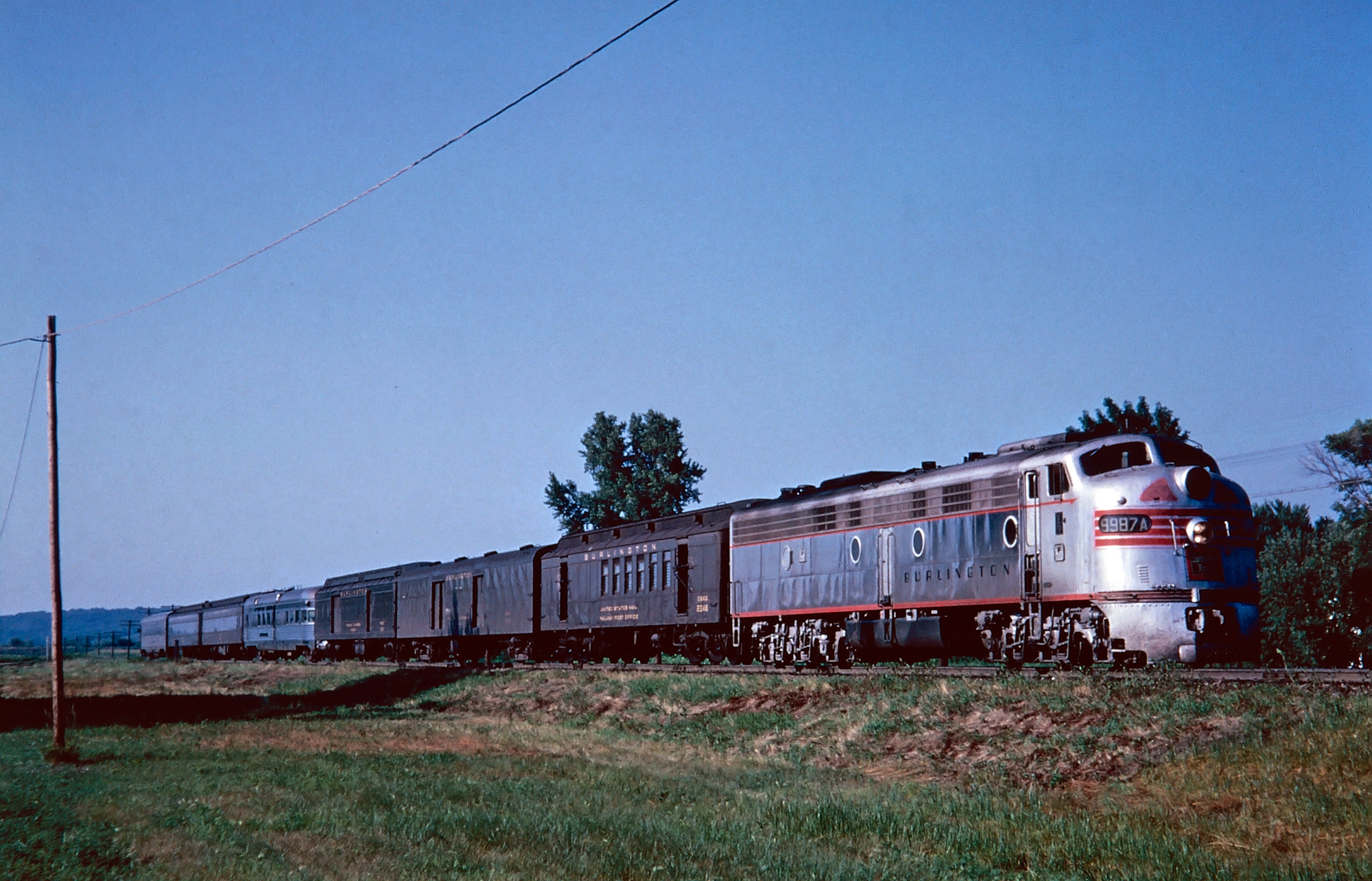 Burlington E9A #9987-A with the evening run between Kansas City and Omaha, circa 1966. This unit was involved in a horrific head-on collision at the interlocking in Montgomery, Illinois on September 27, 1964 when its train was misdirected into a waiting Rock Island passenger train detouring over the CB&Q. It later returned to service although the two other Burlington units involved were scrapped. American-Rails.com collection.
Burlington E9A #9987-A with the evening run between Kansas City and Omaha, circa 1966. This unit was involved in a horrific head-on collision at the interlocking in Montgomery, Illinois on September 27, 1964 when its train was misdirected into a waiting Rock Island passenger train detouring over the CB&Q. It later returned to service although the two other Burlington units involved were scrapped. American-Rails.com collection.Amtrak
Relief for passenger operations would finally come in the way of the National Railroad Passenger Corporation, or Amtrak, signed into law by President Richard Nixon as the Rail Passenger Service Act and the new carrier began operations on May 1st, 1971.
Government-controlled (all common stock is federally owned) and funded, Amtrak operates almost exclusively over the private freight railroads, save for the Northeast where it owns the [mostly] PRR’s former Northeast Corridor (NEC), a four-track main line operating between Washington, D.C. and Boston.
In total Amtrak operates roughly 21,000 miles of track. When it began operations railroads were asked to provide two things to the upstart passenger carrier:
- One-time payments, which would eventually total $190 million (from 13 railroads).
- Equipment (not all of the major Class I's elected to turn their operations over to Amtrak because they either felt they could provide better service or were not financially capable of doing so, such as the Rock Island).
In all, the equipment Amtrak would receive included 300 locomotives and over 1,200 cars.
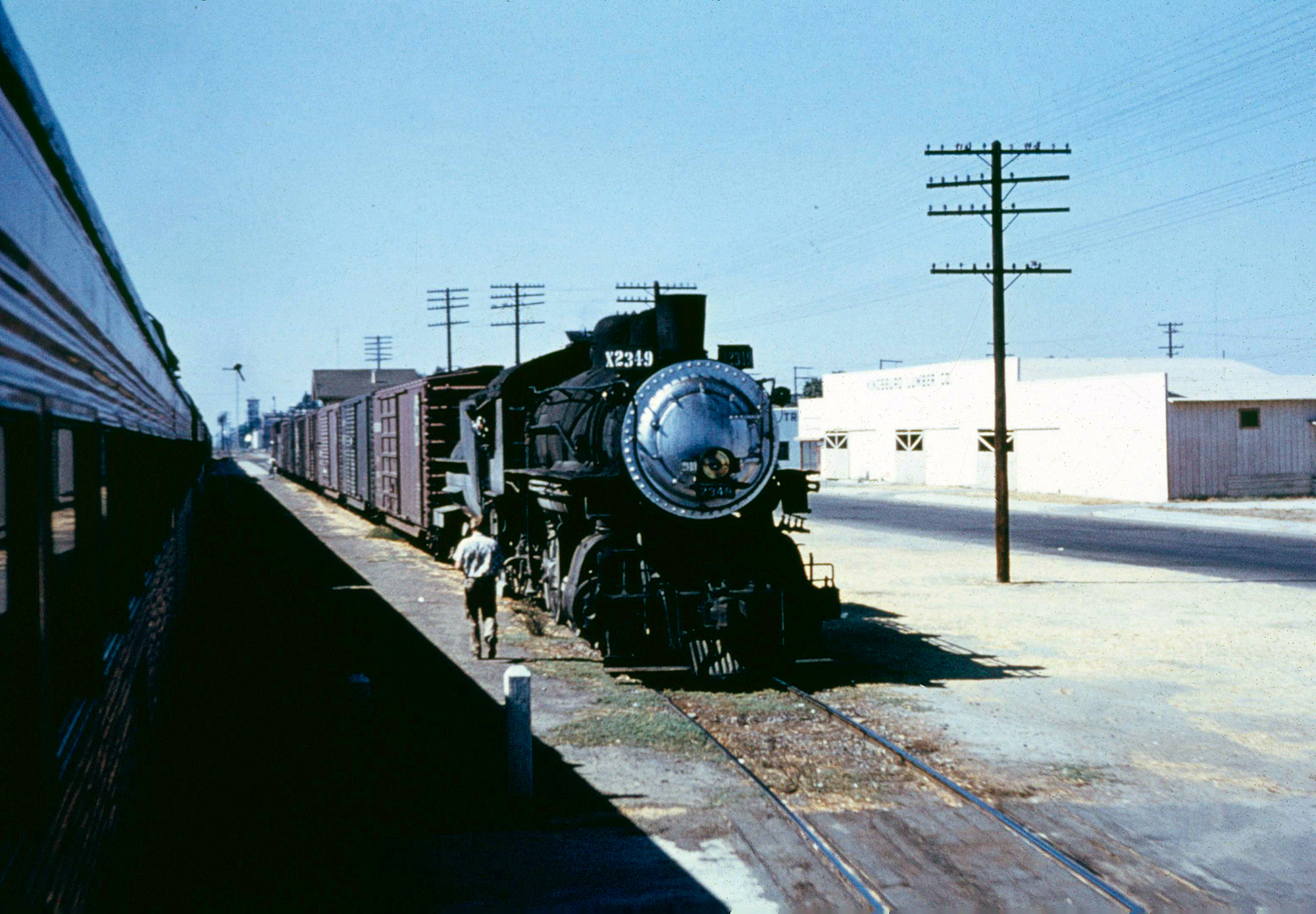 Taken aboard what was most likely Southern Pacific's "San Joaquin Daylight," Herb Cearley captured 2-8-0 #2349 working local service in Kingsburg, California during the 1950's. Author's collection.
Taken aboard what was most likely Southern Pacific's "San Joaquin Daylight," Herb Cearley captured 2-8-0 #2349 working local service in Kingsburg, California during the 1950's. Author's collection.Today
From a railfan perspective perhaps the most interesting time to watch Amtrak was during these early years when a train’s equipment hosted an entire assortment of liveries from railroads all over the country.
On the contrary, however, it was also disappointing to see a number of famous trains discontinued or canceled with Amtrak’s upstart.
While Amtrak was initially intended to become self-supporting (an improbable notion to begin with, passenger rail is rarely profitable) it quickly became obvious after its first year of operations this would not be the case.
In its first year Amtrak earned $163 million with expenses of $310 million. By 1980 things were not much better as the carrier saw $454 million in revenues and $1.08 billion in expenses.
Even though the decline of passenger railroading took place after World War II, until Amtrak’s creation in 1971 the carrier has been steadily improving and just in 2007 broke its all-time ridership record. For more on Amtrak regarding its early years through today please click here.
Recent Articles
-
Nevada's - Murder Mystery - Dinner Train Rides
Jan 07, 26 02:12 PM
Seamlessly blending the romance of train travel with the allure of a theatrical whodunit, these excursions promise suspense, delight, and an unforgettable journey through Nevada’s heart. -
West Virginia's - Murder Mystery - Dinner Train Rides
Jan 07, 26 02:08 PM
For those looking to combine the allure of a train ride with an engaging whodunit, the murder mystery dinner trains offer a uniquely thrilling experience. -
Kansas's - Murder Mystery - Dinner Train Rides
Jan 07, 26 01:53 PM
Kansas, known for its sprawling wheat fields and rich history, hides a unique gem that promises both intrigue and culinary delight—murder mystery dinner trains. -
Michigan's - Wine Tasting - Train Rides
Jan 07, 26 12:36 PM
In this article, we’ll delve into the world of Michigan’s wine tasting train experiences that cater to both wine connoisseurs and railway aficionados. -
Indiana's - Wine Tasting - Train Rides
Jan 07, 26 12:33 PM
In this article, we'll delve into the experience of wine tasting trains in Indiana, exploring their routes, services, and the rising popularity of this unique adventure. -
South Dakota's - Wine Tasting - Train Rides
Jan 07, 26 12:30 PM
For wine enthusiasts and adventurers alike, South Dakota introduces a novel way to experience its local viticulture: wine tasting aboard the Black Hills Central Railroad. -
Kentucky Thomas The Train Rides
Jan 07, 26 12:26 PM
If you’ve got a Thomas fan in the house, Day Out With Thomas at the Kentucky Railway Museum is one of those “circle it on the calendar” weekends. -
Michigan's Thomas The Train Rides
Jan 07, 26 12:10 PM
If you’ve got a Thomas fan in the house, few spring outings feel as “storybook-real” as Day Out With Thomas™ at Greenfield Village in Dearborn, Michigan. -
Texas Dinner Train Rides On The TSR!
Jan 07, 26 11:36 AM
Today, TSR markets itself as a round-trip, four-hour, 25-mile journey between Palestine and Rusk—an easy day trip (or date-night centerpiece) with just the right amount of history baked in. -
Iowa Dinner Train Rides In Boone!
Jan 07, 26 11:06 AM
If you’ve ever wished you could pair a leisurely rail journey with a proper sit-down meal—white tablecloths, big windows, and countryside rolling by—the Boone & Scenic Valley Railroad & Museum in Boon… -
Wisconsin Dinner Train Rides In North Freedom!
Jan 06, 26 10:18 PM
Featured here is a practical guide to Mid-Continent’s dining train concept—what the experience is like, the kinds of menus the museum has offered, and what to expect when you book. -
Pennsylvania Dinner Train Rides In Boyertown!
Jan 06, 26 06:48 PM
With beautifully restored vintage equipment, carefully curated menus, and theatrical storytelling woven into each trip, the Colebrookdale Railroad offers far more than a simple meal on rails. -
North Carolina ~ Murder Mystery ~ Dinner Train Ride
Jan 06, 26 11:26 AM
While there are currently no murder mystery dinner trains in the Tarheel State the Burgaw Depot does host a murder mystery dinner experience in September! -
Florida's - Murder Mystery - Dinner Train Rides
Jan 06, 26 11:23 AM
Florida, known for its vibrant culture, dazzling beaches, and thrilling theme parks, also offers a unique blend of mystery and fine dining aboard its murder mystery dinner trains. -
New Mexico's - Wine Tasting - Train Rides
Jan 06, 26 11:19 AM
For oenophiles and adventure seekers alike, wine tasting train rides in New Mexico provide a unique opportunity to explore the region's vineyards in comfort and style. -
Ohio's - Wine Tasting - Train Rides
Jan 06, 26 11:14 AM
Among the intriguing ways to experience Ohio's splendor is aboard the wine tasting trains that journey through some of Ohio's most picturesque vineyards and wineries. -
Connecticut's Thomas The Train Rides
Jan 06, 26 11:06 AM
For 2026, the tour stop at Essex brings Thomas (and Percy, too) to the historic Valley Railroad for a full day of events for the kids. -
Maryland's Thomas The Train Rides
Jan 06, 26 11:00 AM
In 2026, the B&O Railroad Museum in Baltimore welcomes the Let’s Rock, Let’s Roll Tour with four event days that combine a Thomas-themed excursion with other activities. -
Tennessee's Thomas The Train Rides
Jan 06, 26 10:51 AM
Set on the grounds of one of the Southeast’s best-known operating railroad museums, the Thomas the train event blends kid-friendly fun with the unmistakable sights, sounds, and atmosphere of a real wo… -
Georgia's Thomas The Train Rides
Jan 06, 26 10:44 AM
Day Out With Thomas is set to roll back into Cordele in 2026, bringing Thomas the Tank Engine and a full family festival to the SAM Shortline at Georgia Veterans Memorial State Park.




















